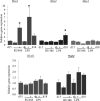Dynamic changes in cervical glycosaminoglycan composition during normal pregnancy and preterm birth
- PMID: 22529214
- PMCID: PMC3380303
- DOI: 10.1210/en.2011-1950
Dynamic changes in cervical glycosaminoglycan composition during normal pregnancy and preterm birth
Abstract
Glycosaminoglycans (GAG) have diverse functions that regulate macromolecular assembly in the extracellular matrix. During pregnancy, the rigid cervix transforms to a pliable structure to allow birth. Quantitative assessment of cervical GAG is a prerequisite to identify GAG functions in term and preterm birth. In the current study, total GAG levels increased at term, yet the abundance, chain length, and sulfation levels of sulfated GAG remained constant. The increase in total GAG resulted exclusively from an increase in hyaluronan (HA). HA can form large structures that promote increased viscosity, hydration, and matrix disorganization as well as small structures that have roles in inflammation. HA levels increased from 19% of total GAG in early pregnancy to 71% at term. Activity of the HA-metabolizing enzyme, hyaluronidase, increased in labor, resulting in metabolism of large to small HA. Similar to mice, HA transitions from high to low molecular weight in term human cervix. Mouse preterm models were also characterized by an increase in HA resulting from differential expression of the HA synthase (Has) genes, with increased Has1 in preterm in contrast to Has2 induction at term. The Has2 gene but not Has1 is regulated in part by estrogen. These studies identify a shift in sulfated GAG dominance in the early pregnant cervix to HA dominance in term and preterm ripening. Increased HA synthesis along with hyaluronidase-induced changes in HA size in mice and women suggest diverse contributions of HA to macromolecular changes in the extracellular matrix, resulting in loss of tensile strength during parturition.
Figures








References
-
- Martin JA. 2011. Preterm births - United States, 2007. MMWR Surveill Summ 60(Suppl):78–79 - PubMed
-
- Cunningham F, Leveno K, Bloom S, Hauth J, Rouse D, Spong C. 2010. Williams obstetrics. 23rd ed New York: McGraw-Hill Professional
-
- Read CP, Word RA, Ruscheinsky MA, Timmons BC, Mahendroo MS. 2007. Cervical remodeling during pregnancy and parturition: molecular characterization of the softening phase in mice. Reproduction 134:327–340 - PubMed
-
- Timmons BC, Mahendroo MS. 2006. Timing of neutrophil activation and expression of proinflammatory markers do not support a role for neutrophils in cervical ripening in the mouse. Biol Reprod 74:236–245 - PubMed
Publication types
MeSH terms
Substances
Grants and funding
LinkOut - more resources
Full Text Sources
Other Literature Sources

